Head-foot, ink-jet brainy suckers – The Cephalopods of the British Isles
Many people don’t have a clue what a cephalopod is. Even if their Greek and Latin is good the translation to ‘head-foot’ isn’t writhing with firm answers. But almost all people know what octopus and squid are and most have at least heard of cuttlefish even if they associate them with budgies.
You could be forgiven for thinking that the trees in Australia amongst which the diminutive parrot, the budgerigar, flies, have cuttle bone growing from them since budgies love them so much! Or, that outside their little shark cages, budgies are actually diving birds that catch cuttlefish. Of course none of this is true, except the bit about budgies being diminutive Australian parrots.
Cuttlebone is the internal skeleton, and buoyancy aid, of the cuttlefish, a type of cephalopod, related to the octopus and squid. These skeletons regularly wash up on our own shores and they are the most tantalising clue, for most of us, that the kraken, asleep or awake, is really out there.
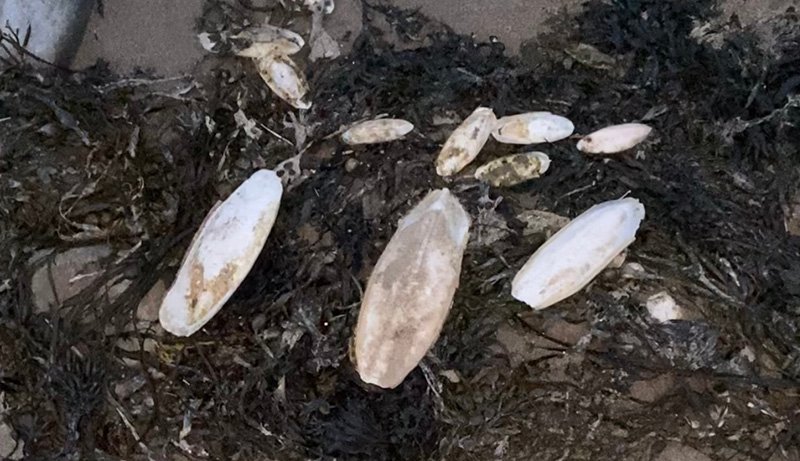
Fascination without flying
If, like me, you are fascinated by octopus, squid and cuttlefish but are worried that flying to exotic places is endangering the existence of those exotic places and prefer to cultivate knowledge and passion for wildlife and natural beauty closer to home, then this might be for you. I wasn’t sure how many cephalopods live around the British Isles, I’m still not exactly certain but I’m closer than I was and I’ve devised a cephalopod clock to help you and me understand our cephalopodia better.
What are Cephalopods?
Cephalopoda is the scientific name of the class of animals within the Phylum Mollusca, the molluscs.
Molluscs are generally renowned for their slowness. Slugs, snails, clams and mussels are all molluscs. But so too are cephalopods which have probably the fastest nervous systems on the planet. They site within the living World like this.
| Kingdom Animalia (Animals) | Animals: from Placozoans and sponges, to Sea Anemones and worms and Sea Lilies and Humans. The other two Kingdoms of multi-cellular organisms large enough to see with the naked eye are plants and the fungi |
| Phylum Mollusca (Molluscs) | Snails, slugs, chitons, bivalves (clams, mussels, cockles, scallops) and cephalopods |
| Class Cephalopoda (Cephalopods)Estimated 1000 species worldwide | Octopus, squid, cuttlefish, nautilus and others all divided into 2 main sub-classes. |
| The 2 cephalopod Sub-classes:Nautiloidea (1 family, 5 species)Coleoidea | Nautiloidea, the nautiluses, have external shells and are not found in British watersColeoidea, octopus, squid, cuttlefish, rams-horn squid, bobtail squid and pygmy squid. |
| The 6 Orders in sub-class Coleoidea Spirulida (1 living species) Sepiida (over 100 species worldwide) Sepiolida (50 -60 species worldwide) Ideosepiida (7 species worldwide) Teuthida (over 250 species worldwide) Vampyromorpha (1 known species) Octopoda (Over 200 species worldwide) | Spirulida – One known tropical species: The Ram’s horn squid Sepiida– Cuttlefishes, found worldwide with 3 British species Sepiolida – The bobtail and bottle-tail squids; found worldwide with about 8 British species Ideosepiida – Pygmy squids; the smallest of all cephalopods; about 7 species (all less than 3cm long from the Pacific and southern oceans. Teuthida – Squids; divided into 2 sub-orders and 18 families worldwide with 5 families (comprising about 12 species) found in British waters. Vampyromorpha – Vampire squids; a single species found in very deep water worldwide Octopoda – The octopuses; divided into 2 sub-orders and 10 families worldwide. Two species (in one family) are found in British coastal waters. |
The Cephalopod Clock
Creating the cephalopod clock was a labour of love. It helped me to understand the species that can be found in British waters, I hope you will find it useful too. To make the piece accessible to everyone it’s available as a fine art print and also as a labelled poster.
Here are more details about the species featured on the clock (starting from the top (12-o’clock and moving clockwise). As arms and tentacles can be extended, I’ve given what I believe to be maximum mantle lengths (ML) for each as this is a more reliable measurement.
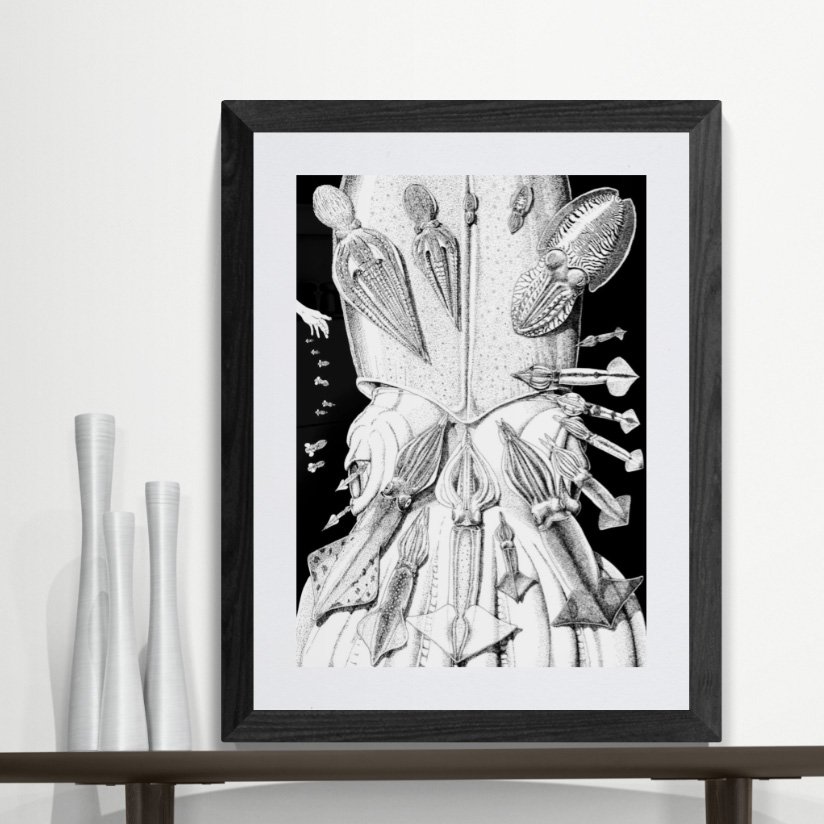
The Cuttlefishes (Order: Sepiida) – Cuttlefish are not squid or octopus.
Each species has a characteristic cuttlebone which can be used to identify the species.
- Elegant Cuttlefish (Sepia elegans) (ML – 7.5cm)
- Pink Cuttlefish (Sepia orbignyana) (ML – 12cm)
- Common Cuttlefish (Sepia officinalis) – (ML – 45cm) By far the largest and commonest cuttlefish in British waters and the species most likely to be found inshore.
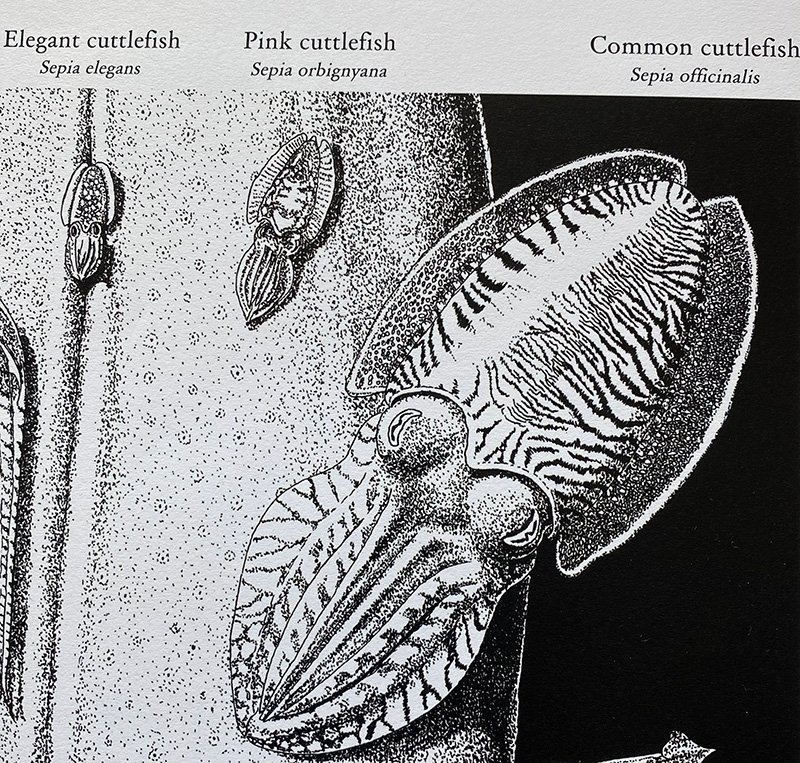
All true squids are in the Order Teuthidae
This is divided into 2 suborders: The oegopsids or ‘naked-eye’ squids and the loliginids or ‘enclosed-eye’ squids.
The Short-finned Squids (in the sub-order Oegopsina)
The oegopsids or ‘naked eye squids’ are divided, worldwide, into about 16 recognised families. Of these, 4 families are found in British waters: OMMASTREPHIDAE (Flying squids), GONATIDAE (Armhook squids), ONYCHTEUTHIDAE (Hooked squids), ARCHITEUTHIDAE (Giant squids). Squids are fast moving and highly gregarious making long-distance (oceanic) migrations as well as ascending from very deep water at night to feed near the surface. This means that their appearance in British waters may be seasonal and occasional.
- Atlantic Gonate Squid (Gonatus steenstrupi) (ML – 15cm) FAMILY GONATIDAE (Armhook squids)
- Boreoatlantic Armhook Squid (Gonatus fabricii) (ML – 40cm) FAMILY GONATIDAE (Armhook squids)
- Broadtail Shortfin Squid (Illex coindetii) (ML – 30cm )FAMILY OMMASTREPHIDAE (Flying Squids)
- Boreal or Northern Shortfin Squid (Illex illecebrosus) (ML – 30cm) FAMILY OMMASTREPHIDAE (Flying Squids)
- Lesser Flying Squid or soft squid (Todaropsis eblanae) (ML – 29cm) FAMILY OMMASTREPHIDAE (Flying Squids)
- European Flying, short-finned, hard or sagittal squid (Todarodes sagittatus) (ML – 60cm) FAMILY OMMASTREPHIDAE
- Common Clubhook Squid (Onychoteuthis banksia) (ML – 35cm) FAMILY ONYCHTEUTHIDAE (Hooked squids)
- Neon or Red Flying Squid (Omastrephes bartramii) (ML – 70cm) FAMILY OMMASTREPHIDAE
As far as I can make out, the boreal squid is at the southern edge of its range here and is quite rare whilst the neon squid, which emerges dramatically from the water and glides many metres at high speed, is at the norther edge of its range and is also rare.
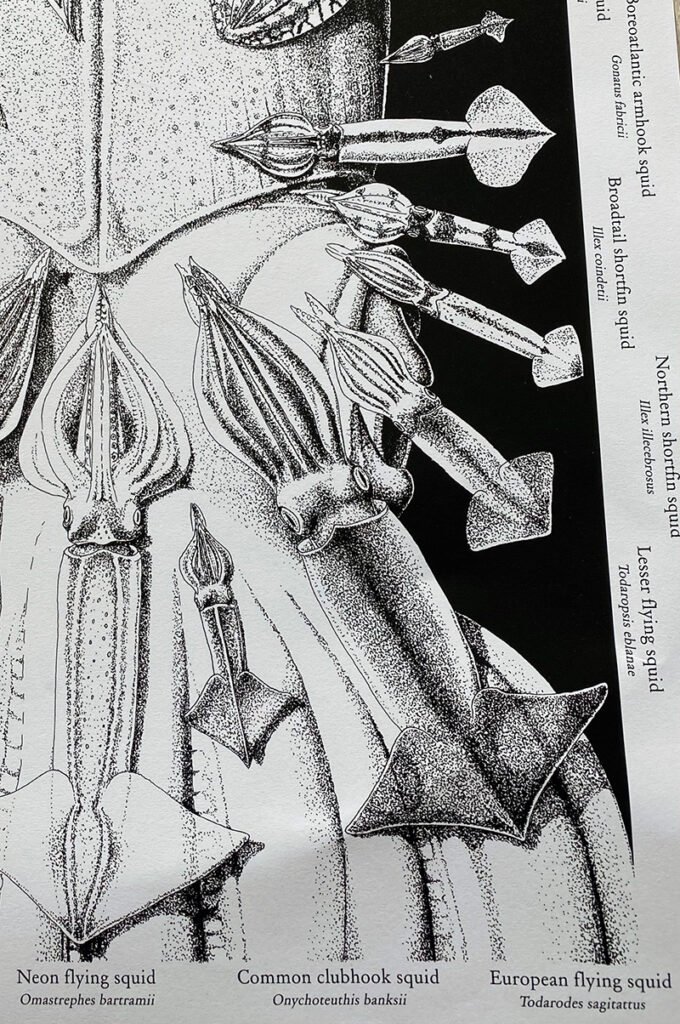
LONG-FINNED SQUIDS (LOLIGINIDS) FAMILY LOLIGINDAE.
This family, (along with the ‘grass squids’ (Family Pickfordiateuthidae) are in the sub-order Myopsina. They are also called ‘Calamari’ squids and are probably the ones most likely to end up on plates and in fish-fryers but oegopsids are widely fished and eaten as well.
- Common European Squid (Loligo vulgaris) (ML – 54cm)
- Veined Squid (Loligo forbesii) (ML – 75cm (up to 90cm in other parts of its range) is the second largest squid to be found in British waters after the considerably larger giant squid. It is the most northern of the long-finned squids.
- European Common Squid (Alloteuthis subulata) (ML – 15cm)
- Midsize or Little Squid (Alloteuthis media) (ML – 15cm)
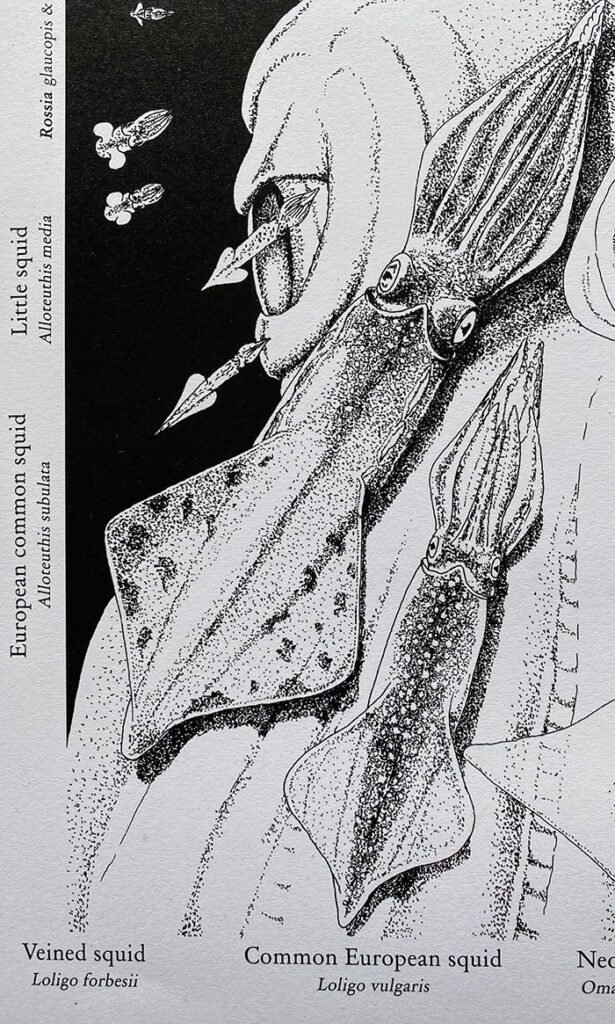
BOBTAIL Squids (SEPIOLIDS) FAMILY SEPIOLIDAE
These are neither true squids nor true cuttlefish. Whilst the pygmy squids can be smaller, the smallest of our bobtails rival them in minisculeness. Most live offshore beyond the low tideline and are rarely seen even by divers but please scroll down to the little Atlantic cuttle below.
- Chilean Bobtail (Rossia glaucopis) (ML – 6cm)– I’m confused about this species. Some sources call it Chilean, others place it in European and UK waters.
- Stout Bobtail Rossia macrosoma (ML – 9cm)
- Sepietta neglecta – (ML – 3.5cm) has no common name I can find. It’s the neglected Bobtail squid!
- Common Bobtail (Sepietta oweniana) (ML – up to 3.5cm)
- Dwarf Bobtail (Sepiola rondeleti) (ML – up to 6cm)
- Little Atlantic Cuttle (Sepiola atlantica) (ML – 2.8cm) – This is our most accessible cephalopod as it enters very shallow water on sandy beaches in the summer. The trouble is that it is so small and so capable of colour change, that it is difficult to spot. Look out for a short-bodied being, swimming in pulses just where the waves break (about shin-depth) on a calm sunny day.
- Golden Bobtail Sepiola aurantiaca (ML – 2cm)
- Sepiola pfefferi – (ML – 1.3cm) Another bobtail with no common name. Its validity as a species is under question but, as it was named by Johan Grimpe in 1921, I’m going to call it Grimpe’s bobtail.

Our cephalopod clock does not really do the bobtails justice and all we’re really trying it say is that they’re here, there are a few species and they are small but pretty and worth a closer look.
Octopuses – FAMILY: OCTOPODIDAE
- Common Octopus Octopus vulgaris – (ML – 25cm; total length 1 metre) Normally rare in British waters, common octopus are common further south in Europe and the Mediterranean and have been known to reach ‘plague’ numbers in our waters though that has not been the case since the 1960s.
- Curled Octopus Eledone cirrhosa – (ML – 25cm; total length 50cm) this is the octopus most likely to be seen in British and north European waters. It is also our logo. For our experiences with this beauty see – For the love of octopus. It is smaller than the common octopus (mainly due to its shorter arms) and has a single row of suckers on each arm where as the common octopus has two. It has the habit of curling up its arms which give it its common name but it also extends little fleshy points above its eyes which have earned it the alternative name, ‘horned octopus’.

That brings us back to 12 o clock and the elephant in the room, lurking behind the others…
Giant squid (Architeuthis dux)
(ML- 2 metres) specimens have been found in English, Scottish and Irish waters. The Giant squid is possibly the only member of the FAMILY ARCHITEUTHIDAE but more closely related to the short-finned squids than the others shown. Our specimen is based on one washed up in Scarborough in 1933. We couldn’t fit the whole animal onto the cephalopod clock without reducing the bobtails to tiny dots but what you see is our best attempt to represent the shapes and sizes of our cephalopods. There are some deep water species not included because they either live outside UK and Irish territorial waters or they are highly unlikely to be seen alive or washed ashore.
You can read more about the giant squid here >>>
Cephalopod Love
You may have noticed a small obsession with cephalopods here! We’re delighted that many of you share our obsession. We have just added these new cephalopod T-shirts and sweatshirts to our range, with more to come soon.

